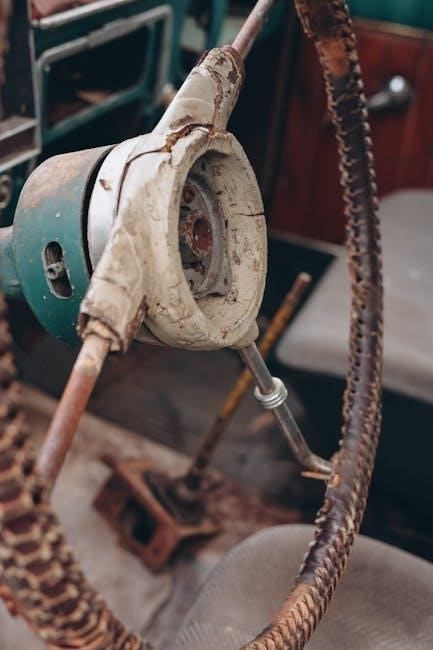
The 2007 Toyota Camry Owner’s Manual is a comprehensive guide to understanding and maintaining your vehicle. It provides essential information on features, maintenance, and troubleshooting, ensuring optimal performance and safety. Download the PDF version for easy access and reference.
1.1 Importance of Reading the Manual
Reading the 2007 Toyota Camry Owner’s Manual is crucial for understanding your vehicle’s features, maintenance requirements, and safety guidelines. It provides detailed instructions for optimal performance, troubleshooting, and proper care. By reviewing the manual, you can avoid potential issues and ensure your car runs efficiently. The manual highlights essential maintenance schedules, fluid checks, and safety precautions, helping you maintain reliability and longevity. Ignoring the manual may lead to overlooked maintenance, which could result in costly repairs. Additionally, it serves as a reference for diagnosing common problems and offers guidance for DIY repairs. The manual also includes specific tips for hybrid models, emphasizing the importance of regular servicing. Whether you’re a new owner or familiar with the Camry, the manual is an indispensable resource. Download the PDF version for easy access and ensure you’re equipped to handle all aspects of your vehicle’s care.
- Understand maintenance schedules and fluid checks.
- Identify safety features and operating instructions.
- Troubleshoot common issues effectively.
- Learn DIY repair tips and guidelines.
- Access hybrid-specific servicing recommendations.
Regularly referencing the manual ensures you maximize your car’s performance and reliability while avoiding unnecessary repairs.
1.2 Where to Find the Owner’s Manual

Your Toyota Camry 2007 Owner’s Manual can be found in multiple convenient locations to ensure easy access. The primary location is the glove compartment of your vehicle, where a printed copy is typically stored. If the manual is missing or you prefer a digital version, you can download it from Toyota’s official website. Simply visit the support section, enter your vehicle’s details, and access the PDF version. Additionally, local Toyota dealerships often provide copies upon request. For added convenience, save the digital manual on your smartphone or tablet for quick reference while on the go. Ensure you have a copy handy to refer to maintenance schedules, troubleshooting guides, and operational instructions. Keeping the manual accessible helps you stay informed and proactive about your car’s care.
- Glove compartment in your Toyota Camry.
- Toyota’s official website for a downloadable PDF.
- Local Toyota dealerships for a physical copy.
- Digital versions saved on your smartphone or tablet.
Having the manual readily available ensures you can address any questions or concerns promptly.
1.3 Key Sections to Focus On
The Toyota Camry 2007 Owner’s Manual is divided into several key sections that are essential for understanding and maintaining your vehicle. Begin with the Table of Contents, which provides a clear overview of the manual’s structure. The Maintenance Schedule section is crucial, as it outlines the recommended services and timelines to keep your car in optimal condition. Pay attention to the Operating Instructions, which explain how to use features like the infotainment system, climate control, and safety systems. The Safety Precautions section is vital for understanding proper driving practices and emergency procedures. Additionally, the Troubleshooting Guide helps diagnose common issues, while the Specifications section provides technical details about your vehicle. Finally, familiarize yourself with the Warranty Information to understand coverage and requirements. By focusing on these sections, you’ll gain a comprehensive understanding of your Toyota Camry and ensure proper care and operation.
- Maintenance Schedule for routine service.
- Operating Instructions for vehicle features.
- Safety Precautions for driving and emergencies.
- Troubleshooting Guide for common issues.
- Specifications for technical details.
- Warranty Information for coverage details.

Key Features of the 2007 Toyota Camry
The 2007 Toyota Camry offers a blend of power, efficiency, and comfort. It features a 2.4L or 3.5L engine, smooth transmission options, and a spacious interior. The Camry also boasts advanced safety features, including ABS and airbags, ensuring a secure driving experience.
- Powerful engine options for enhanced performance.
- Fuel-efficient design for better mileage.
- Comfortable and roomy interior for passengers.
- Advanced safety features for protection.
- Modern technology and entertainment systems.
2.1 Overview of the 2007 Model
The 2007 Toyota Camry represents a significant redesign, offering improved performance, fuel efficiency, and interior comfort. Built on a new platform, it features a more aerodynamic exterior design and a spacious cabin. The Camry was available in multiple trim levels, catering to a wide range of drivers. Its interior boast(ed) modern amenities, including advanced audio systems, climate control, and optional features like a moonroof. The 2007 model emphasized safety, with standard anti-lock braking (ABS) and multiple airbags. It also introduced a more refined driving experience, with a focus on reliability and durability. Whether for daily commuting or family use, the Camry proved to be a versatile and dependable choice. This overview highlights the key attributes that made the 2007 Camry a standout in its class.
2.2 Engine Specifications and Options
The 2007 Toyota Camry offers a range of engine options to suit different driving preferences; The base model features a 2.4-liter inline-4 cylinder engine, producing 158 horsepower and 161 lb-ft of torque. This engine is known for its fuel efficiency and smooth operation. For those seeking more power, a 3.5-liter V6 engine is available, delivering 268 horsepower and 248 lb-ft of torque. This V6 option provides a more dynamic driving experience while maintaining reliability. Both engines are paired with a 5-speed automatic transmission, ensuring responsive acceleration and seamless gear shifts. Additionally, Toyota introduced a hybrid version, combining a 2.4-liter gasoline engine with an electric motor for enhanced fuel economy without compromising performance. These engine options cater to a variety of needs, from eco-conscious drivers to those who prioritize power. The 2007 Camry’s engine lineup underscores Toyota’s commitment to delivering both efficiency and performance.
2.3 Transmission Types Available
The 2007 Toyota Camry offers a variety of transmission options to enhance driving performance and efficiency. The base model comes with a 5-speed manual transmission, providing precise control and fuel efficiency for drivers who prefer a hands-on experience. Additionally, a 5-speed automatic transmission is available, offering smooth gear shifts and effortless acceleration, making it ideal for both city and highway driving. For those seeking enhanced performance, the Camry XLE V6 model features a 6-speed automatic transmission with sequential manual shift mode, allowing drivers to switch between automatic and manual shifting for more dynamic control. This versatility in transmission options ensures that the 2007 Camry meets the needs of a wide range of drivers, whether prioritizing fuel efficiency, ease of use, or sporty performance. These transmission choices complement the engine options, further solidifying the Camry’s reputation for reliability and adaptability.
2.4 Fuel Efficiency and Performance
The 2007 Toyota Camry is designed to deliver a balance of fuel efficiency and performance, making it a practical choice for everyday driving. With its 2.4-liter 4-cylinder engine, the Camry achieves an EPA-estimated 21 MPG in the city and 31 MPG on the highway when paired with the 5-speed manual transmission. The 3.5-liter V6 engine, available in higher trims, offers more power while still maintaining respectable fuel economy at 24 MPG city and 33 MPG highway with the 6-speed automatic transmission.
Both engine options are paired with transmissions that optimize fuel efficiency without compromising performance; The 4-cylinder engine is ideal for commuters seeking lower fuel costs, while the V6 provides smooth acceleration for those who prioritize power. Regular maintenance, such as oil changes and tire pressure checks, ensures optimal fuel efficiency and overall performance.
Drivers can further enhance fuel economy by adopting driving habits like maintaining consistent speeds and avoiding aggressive acceleration. This combination of efficiency and capability makes the 2007 Camry a versatile vehicle for a wide range of driving needs.

Maintenance Schedule and Tips
Regular maintenance is crucial for extending the life of your 2007 Toyota Camry. Follow the recommended schedule for oil changes, tire rotations, and fluid checks to ensure optimal performance and reliability.
3.1 Scheduled Maintenance Requirements
The 2007 Toyota Camry owner’s manual outlines a detailed maintenance schedule to ensure the vehicle runs efficiently and reliably. Regular maintenance is required at specific mileage intervals, such as every 5,000 miles for oil changes and tire rotations. At 15,000 miles, the air filter and spark plug wires should be inspected, while the timing belt is recommended to be replaced at 90,000 miles to prevent engine damage. The manual also specifies intervals for brake fluid, coolant, and transmission fluid replacements to maintain optimal performance. Neglecting these scheduled services can lead to premature wear and potential breakdowns. Always refer to the manual for exact intervals and procedures tailored to your driving conditions, whether normal or severe. Staying on track with these requirements helps preserve the Camry’s longevity and ensures a smooth driving experience.
3.2 Oil Change and Fluid Guidelines
The 2007 Toyota Camry owner’s manual provides clear guidelines for oil changes and fluid maintenance to ensure optimal performance. The recommended oil viscosity is 0W-20, which is designed to improve fuel efficiency and protect the engine in extreme temperatures. Oil changes should be performed every 5,000 to 7,500 miles, depending on driving conditions. Additionally, the manual specifies the proper procedure for draining the oil, replacing the oil filter, and refilling with the correct amount. Other essential fluids, such as brake fluid, coolant, and transmission fluid, also require regular checks and replacements. Brake fluid levels should be inspected monthly, and coolant should be replaced every 30,000 to 50,000 miles to prevent corrosion. Transmission fluid levels should be checked with the engine running and the car on level ground. Always use Toyota-approved fluids to maintain warranty validity and ensure compatibility with your vehicle’s systems. Regular fluid checks prevent overheating, corrosion, and premature wear on critical components. Proper disposal of used fluids and filters is also emphasized to protect the environment. By following these guidelines, you can extend the life of your Camry and maintain its performance.
3.3 Tire Pressure and Care
The 2007 Toyota Camry owner’s manual emphasizes the importance of maintaining proper tire pressure for safety, fuel efficiency, and handling. The recommended tire pressure for most models is 30-35 PSI, but exact specifications can be found on the tire information placard on the driver’s side doorjamb or in the manual. It’s crucial to check tire pressure when the tires are cold, as driving can increase pressure temporarily. Underinflated tires can lead to reduced fuel efficiency, uneven wear, and increased risk of a blowout. The manual also recommends rotating tires every 5,000 to 8,000 miles to ensure even tread wear. Inspect tires regularly for signs of wear, such as uneven patterns or cracks, and replace them when tread depth reaches 1/16 of an inch. Proper wheel alignment is also essential to prevent uneven tire wear. Always use a spare tire temporarily and at the recommended speed. Cleaning tires with mild soap and avoiding hazardous road conditions can further extend their lifespan. Regular tire care ensures optimal performance and safety on the road.
3.4 Importance of Regular Fluid Checks

Regular fluid checks are vital for maintaining the health and performance of your 2007 Toyota Camry. The owner’s manual highlights several key fluids to monitor, including engine oil, transmission fluid, coolant, brake fluid, and power steering fluid. Engine oil lubricates the engine and prevents overheating, while transmission fluid ensures smooth gear shifts. Coolant maintains the optimal temperature range for the engine and prevents corrosion. Brake fluid is essential for the proper functioning of the braking system, and power steering fluid ensures smooth steering operation. The manual recommends checking these fluids at least once a month or before long trips. Low fluid levels or contamination can lead to serious mechanical issues, costly repairs, and even safety hazards. Always use the types of fluids specified in the manual to avoid compatibility problems. Keep track of fluid changes and top-ups to maintain your Camry’s longevity and reliability. Regular fluid checks are a simple yet crucial part of routine maintenance.

Common Issues and Troubleshooting
The 2007 Toyota Camry may experience issues like engine oil consumption, transmission slipping, or electrical malfunctions. The manual provides guidance on identifying symptoms, diagnostic steps, and repair solutions to ensure optimal performance and safety.
4.1 Engine Oil Consumption Solutions
The 2007 Toyota Camry may experience higher-than-normal engine oil consumption due to factors like PCV valve issues or worn piston rings. Regularly check oil levels and top up as needed using the recommended viscosity grade. Inspect the PCV valve for blockages or damage and replace it if necessary. If oil leaks are suspected, inspect gaskets and seals around the engine. Addressing these issues promptly can prevent excessive oil loss and potential engine damage. Ensure proper driving habits, as aggressive acceleration or frequent stop-and-go driving can increase oil consumption. If the problem persists, consult a certified mechanic to check for internal engine wear, such as worn piston rings or cylinder walls. Always refer to the owner’s manual for guidelines on oil types and maintenance schedules to mitigate oil consumption effectively.
4.2 Identifying Transmission Problems
Identifying transmission issues in the 2007 Toyota Camry can be done by monitoring specific symptoms. Common signs include slipping or hesitation between gears, delayed engagement when shifting from park to drive, and unusual noises such as clunking or whining sounds during acceleration. These problems may stem from low transmission fluid levels, dirty fluid, or internal component wear. Check the transmission fluid regularly, ensuring it is at the recommended level and free from contamination. If the fluid is dirty or low, consider a transmission fluid change. Additionally, pay attention to any warning lights on the dashboard, such as the “Check Engine” light, which may indicate transmission-related trouble codes. Scanning for codes with an OBD-II scanner can provide more specific information. If you notice any of these symptoms or codes, consult a professional mechanic for a thorough inspection and necessary repairs to prevent further damage to the transmission system.
4.3 Electrical System Issues and Fixes
The 2007 Toyota Camry may experience electrical system issues, often manifesting as flickering dashboard lights, dead battery scenarios, or malfunctioning power accessories. These problems can arise from faulty sensors, corroded connections, or a failing alternator. To diagnose, start by checking the battery terminals for corrosion and ensuring they are tightly connected. If the battery is dead, attempt a jump-start using proper techniques outlined in the manual. For flickering lights, inspect the alternator belt for wear and tension, as a slipping belt can disrupt charging. Additionally, check for blown fuses in the fuse box, located under the dashboard or in the engine compartment, as indicated in the manual. Replace any blown fuses with the correct amperage rating. If issues persist, such as intermittent power to accessories, inspect wiring harnesses for damage or moisture. Consult a certified mechanic if problems are complex or recurring, as advanced electrical diagnostics may require specialized tools and expertise.
4.4 Recalls and Necessary Repairs
Toyota issued several recalls for the 2007 Camry to address safety and performance concerns. Owners should check if their vehicle is affected by visiting Toyota’s official website or contacting a local dealership. Common recalls include issues with the fuel pump, which may fail and cause engine stalling, and the power window switch, which could overheat and pose a fire risk. If your Camry is subject to a recall, it is crucial to schedule repairs promptly to ensure safety and prevent further damage. Repairs are typically free of charge and performed by authorized Toyota service centers. Always verify the recall status using your Vehicle Identification Number (VIN) to avoid missing critical updates. Addressing recalls ensures your Camry remains safe, reliable, and compliant with safety standards. Regularly checking for recalls and completing necessary repairs is a proactive step to maintain your vehicle’s performance and longevity.

DIY Guides and Repairs
Explore step-by-step guides for common repairs like oil changes, air filter replacements, and brake pad installations. Learn to identify tools and materials needed for DIY maintenance to keep your Camry running smoothly.
5.1 Step-by-Step Oil Change Guide
Changing the oil in your 2007 Toyota Camry is a straightforward process that helps maintain engine health. Start by gathering materials: a socket wrench, oil filter wrench, drain pan, new oil filter, and enough motor oil (4.5 quarts for 2.4L, 4 quarts for 3.5L). Warm the engine by driving for a few minutes to ensure the oil drains easily. Locate the oil drain plug underneath the car, near the front. Use the socket wrench to remove the plug and let the oil flow into the drain pan. Once drained, replace the plug securely. Next, remove the oil filter using the oil filter wrench and install a new one. Pour in the recommended oil type, as specified in the manual. Replace the oil cap and start the engine to circulate the new oil. Check for leaks and dispose of the used oil responsibly. Always refer to the manual for specific details. This simple process ensures your Camry runs smoothly and prolongs engine life. Proper disposal is crucial for environmental protection. Regular oil changes are essential for maintaining your vehicle’s performance and longevity. Follow these steps carefully to avoid any mistakes. Keep track of when you perform the oil change to stay on schedule. A well-maintained engine reduces the risk of costly repairs down the road. By following this guide, you can confidently perform an oil change at home, saving time and money. Always prioritize safety when working under your vehicle. If unsure, consult a professional mechanic for assistance. This DIY guide empowers you to take control of your car’s maintenance, ensuring reliability and efficiency. Oil changes are a fundamental part of car care, and mastering this process will benefit you for years to come. Remember to check your owner’s manual for any specific recommendations tailored to your Camry’s model. Stay proactive with maintenance to enjoy a trouble-free driving experience. Regular oil changes are a cornerstone of proper vehicle upkeep. By adhering to this guide, you can ensure your Toyota Camry remains in optimal condition. This process is designed to be user-friendly, even for those new to DIY car maintenance. Take pride in caring for your vehicle and keep it running like new. Oil changes are a simple yet critical task that every car owner should understand. With this guide, you’re equipped to handle it with confidence. Keep your Camry performing at its best by following this step-by-step oil change guide.
5.2 Replacing Brake Pads at Home
Replacing brake pads on your 2007 Toyota Camry can be done at home with the right tools and knowledge. Start by gathering essential tools like a lug wrench, C-clamp, screwdrivers, and new brake pads. Ensure the car is on a level surface with the parking brake engaged. Loosen the lug nuts with the wrench but do not remove them yet. Raise the car using a jack and secure it with jack stands for safety. Remove the wheels to access the brake assembly.
Locate the caliper, which holds the brake pads, and remove it by unscrewing the bolts. Slide out the old pads and insert the new ones. Use the C-clamp to compress the caliper, ensuring space for the new pads. Reassemble everything, tightening all bolts securely. Check if bleeding the brakes is necessary, though it’s typically not required if brake lines remain intact.
Safety is paramount; ensure the car is stable and consider having a helper. If unsure, consult a professional or the owner’s manual. While challenging, this DIY task can save money and empower you with hands-on experience. Proceed methodically to ensure safety and effectiveness.
5.3 Changing the Air Filter
Changing the air filter in your 2007 Toyota Camry is a straightforward process that improves engine performance and fuel efficiency. Start by locating the air filter housing, usually found under the hood on the driver’s side. Open the housing by releasing the clips or screws, depending on the model. Once open, carefully pull out the old air filter and inspect it for dirt or debris.
Replace the old filter with a new one, ensuring it is properly seated and aligned. Close the housing and secure it with the clips or screws. Turn the ignition to the “ON” position and listen for any unusual sounds to confirm the filter is installed correctly. Regular air filter changes, recommended every 15,000 to 30,000 miles, help maintain your car’s efficiency and longevity; Always refer to the owner’s manual for specific guidelines tailored to your vehicle.
This simple maintenance task can be done at home with basic tools, saving time and money while keeping your Camry running smoothly.
5.4 Spark Plug Replacement Tips
Replacing the spark plugs in your 2007 Toyota Camry is essential for maintaining optimal engine performance and fuel efficiency. Spark plugs should be replaced every 30,000 to 100,000 miles, depending on the type and usage. Start by gathering the necessary tools, including a spark plug socket, torque wrench, and protective gloves.

Locate the spark plugs near the engine cylinders, accessed by removing the ignition coil packs. Use the spark plug socket to remove the old plugs, ensuring not to round the spark plug holes. Install the new plugs by hand to avoid cross-threading, then tighten them with the torque wrench to the specified torque.
Avoid using the wrong socket size, as it can damage the spark plug or threads. Always replace all spark plugs at once for balanced engine performance. Use high-quality spark plugs designed for your Camry’s engine type. Refer to the owner’s manual for specific torque values and recommendations. This DIY task is manageable with the right tools and precautions.

Accessories and Modifications
This section provides guidance on enhancing your Toyota Camry with accessories and modifications, focusing on appearance and performance while ensuring compatibility and safety with factory-approved or high-quality recommended aftermarket parts.
6.1 Popular Interior Modifications
Interior modifications for the 2007 Toyota Camry can enhance comfort, style, and functionality. Popular upgrades include premium seat covers, which offer improved durability and aesthetics, available in materials like leather or high-quality fabric. Custom dashboard trim kits can modernize the cabin with wood grain or carbon fiber finishes. Upgrading the infotainment system with a modern touchscreen or adding Bluetooth connectivity is another common modification. Many owners opt for aftermarket steering wheels that combine style and better grip. Additionally, LED ambient lighting and customizable floor mats are popular for personalizing the interior. For practicality, storage solutions like center console organizers or trunk dividers are often installed. These modifications not only personalize the vehicle but also maintain its functionality and comfort. Always ensure that any modifications comply with the owner’s manual guidelines to avoid compromising safety or system performance.
6.2 Exterior Enhancements for Style
Exterior enhancements for the 2007 Toyota Camry can significantly boost its visual appeal and make it stand out. Popular modifications include the installation of a front spoiler or body kit, which adds a sporty and aerodynamic look; Upgrading to alloy wheels or custom rims can enhance both style and performance. LED lighting strips or fog lights are also popular for a modern appearance. Many owners opt for window tinting to improve privacy and give the car a sleek, polished look. Additionally, a rear spoiler or trunk lid spoiler can add a dynamic touch. Custom paint jobs or vinyl wraps are another way to personalize the exterior, offering unique designs or color schemes. Grille upgrades, such as a chrome or mesh grille, can also elevate the car’s front aesthetic. These exterior modifications not only enhance style but also reflect the owner’s personal taste while maintaining the Camry’s timeless appeal. Always ensure modifications comply with local regulations and safety standards.
6.3 Performance Upgrades to Consider

For owners seeking to enhance the performance of their 2007 Toyota Camry, several upgrades can make a noticeable difference. One popular option is upgrading the air intake system to a cold air intake, which improves airflow and can increase horsepower. Installing a high-performance exhaust system, such as a cat-back exhaust, can also enhance power output and give the engine a sportier sound. Another consideration is upgrading the suspension with stiffer springs or coilovers to improve handling and reduce body roll. Additionally, lightweight alloy wheels paired with high-performance tires can improve acceleration and cornering capabilities. For those looking to optimize engine performance, an ECU tune can refine fuel injection and ignition timing for better power delivery. These upgrades not only enhance the driving experience but also allow owners to personalize their Camry’s performance characteristics. Always ensure that modifications comply with local regulations and are installed by a qualified technician to maintain reliability and safety.
6.4 Tech Accessories for Modernization
Modernizing your 2007 Toyota Camry with tech accessories can significantly enhance its functionality and convenience. One popular upgrade is installing an aftermarket infotainment system with touchscreen functionality, Bluetooth connectivity, and smartphone integration via Android Auto or Apple CarPlay. This allows for seamless navigation, music streaming, and hands-free calls. Additionally, consider adding a backup camera to improve safety during reversing maneuvers. Another useful accessory is a wireless charging pad, which keeps your phone charged without the clutter of cables. For better illumination, LED interior and exterior lighting kits can be installed to provide brighter, more energy-efficient light. Lastly, upgrading to a modern alarm system with keyless entry or a remote starter can add convenience and security. These tech upgrades not only bring your Camry up to date with modern vehicles but also enhance your overall driving experience. Always consult the owner’s manual or a professional installer to ensure compatibility and proper installation.




